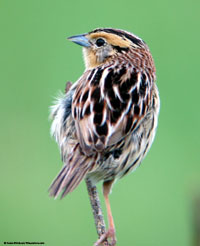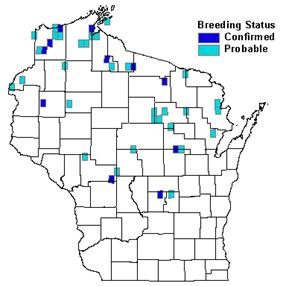

Status/Protection
- Global Rank: G4 Key to global and state ranks
- State Rank: S2S3B
- WBCI Priority: SGCN, PIF, State Special Concern
Population Information
The Federal BBS information can be obtained at http://www.mbr-pwrc.usgs.gov/bbs/bbs.html by clicking on Trend Estimates and selecting the species in question. All estimates are for time period (1966-2005).
*Note: There are important deficiencies with these data. These results may be compromised by small sample size, low relative abundance on survey route, imprecise trends, and/or missing data. Caution should be used when evaluating this trend.
- Federal Breeding Bird Survey: non-significant decline
- Federal Breeding Bird Survey (WI): significant decline*
- Federal Breeding Bird Survey (BCR 23): non-significant decline*
- Federal Breeding Bird Survey (BCR 12): significant increase
- WSO Checklist Project: significant inverted u-shaped quadratic trend (1983-2007)
Life History
- Breeding Range: Prairie Provinces of Canada and extreme north-central U.S. (Lowther 1996).
- Breeding Habitat: Northern Sedge Meadow and Marsh, Open Bog-Muskeg, Hay, Idle Cool Season Grasses.
- Nest: Open cup on or slightly above ground, composed of fine grasses, rushes, sedges (Ehrlich 1988).
- Nesting Dates: Late May – Early July (Lowther 1996).
- Foraging: ground gleaning (Ehrlich 1988).
- Migrant Status: Short-distance migrant (Lowther 1996).
- Habitat use during Migration: similar to wintering habitat (Lowther 1996).
- Arrival Dates: late April – early May (Robbins 1991).
- Departure Dates: August-September (Robbins 1991).
- Winter Range: South-central U.S. Missouri to the Gulf of Mexico (Lowther 1996).
- Winter Habitat: old fields, prairie with dense grasses and sedges (Lowther 1996).
Habitat Selection
LeConte’s Sparrows prefer large, level, relatively undisturbed, grass/sedge habitats (Robbins 1991), typically with relatively tall, dense vegetation and abundant residual vegetation (Sample and Mossman 1997, DeChant et al. 2003). In Wisconsin, LeConte’s Sparrows are specialists of northern sedge meadows, sedge marsh, and mossed bogs, but are also found in fallow fields, grass-dominated hay fields and pastures. Pastures or working grasslands must not be intensively managed for LeConte’s Sparrows to be present. They are intolerant of shrubs or woody vegetation in and around nesting sites (Sample and Mossman 1997). LeConte’s Sparrows nest just above the ground in a grass clump (Lowther 1996) and utilize dead grasses and sedges with a grassy canopy (Lowther 1996).
There currently is little information available regarding the area requirements of LeConte’s Sparrow (DeChant et al. 2003). Winter et al. 2005 found LeConte’s Sparrow were not sensitive to patch size or distance to forest in North Dakota. Anecdotally speaking, LeConte’s Sparrows tend to be found reliably in the large, open sedge meadows in northern Wisconsin, however; more research needs to be done regarding this aspect of life history. In NW Wisconsin they also occur in smaller agricultural grassland fields, including hayfields or sites less than 20 acres in extent (Paulios pers. observation).
In migration and winter, LeConte’s Sparrows are found in a variety of old fields, weedy areas, open grassy fields, and low-lying flat areas with rank vegetation (Lowther 1996).
Habitat Availability
LeConte’s Sparrows are a regular breeder in the northern third of Wisconsin (Robbins 1991) and are locally found in large sedge meadows in glacial lake Wisconsin and scattered locations in central Wisconsin such as Comstock Bog. The large sedge meadows associated with Glacial Lake Grantsburg at Crex Meadows Wildlife and Fish Lake Wildlife Area along with the surrounding ag fields probably contain hundreds, if not thousands of pairs of this species. The wet, rank hay fields and pastures on the Superior Clay Plain in Douglas/Bayfield/Ashland counties also contain large populations.
Many of these large sedge meadow complexes in northern Wisconsin are protected as wildlife areas or other public properties and are not expected to diminish in extent. Populations of this species on grass-based agricultural fields in northern Wisconsin are probably declining as this habitat type has declined.
Population Concerns
The Federal BBS trend for LeConte’s Sparrow in Wisconsin suggests extreme long-term population declines (Sauer et al. 2004). However; this species was found on a very small number of routes and the corresponding population trend is very imprecise. LeConte’s Sparrows are very secretive and difficult to detect and this low detectability makes population estimates and trends difficult to determine. This species is not well monitored by BBS in Wisconsin due to this secretive nature and use of remote wetland habitats. Range-wide trends suggest stable populations and are probably more representative of the global trend for this species due to low population sizes in Wisconsin.
Recommended Management
Practices that maintain residual vegetation and maintain relatively tall grassland structure will attract LeConte’s sparrows within their range. Species such as LeConte’s Sparrows that require dense litter layers, but are sensitive to woody encroachment require careful planning for proper habitat maintenance. Burning or mowing hay fields, grasslands and sedge meadows is required to rejuvenate vegetation and control woody growth. For this and other species burn cycles should probably be no sooner than every 4 years, and isolated patches of suitable habitat should not be burned or mowed in their entirety (DeChant et al. 2003). There currently is no direct research assessing the effects of management (or lack thereof) on this and other sedge meadow species in Wisconsin.
Research Needs
There is very little nesting data on LeConte’s Sparrows due to their secretive nature and well-concealed nests. Only 3 studies (most recent in 1969) have been conducted anywhere on their breeding grounds. This lack of information makes proper management difficult (Lowther 1996). Research in Wisconsin on area requirements and effects of management would aid management efforts. Due to its habitat selection in Wisconsin, it’s difficult to assess population trends at the state level and it’s unknown how many pairs actually exist on a yearly basis. More effort in detection and breeding studies aimed at this species and other secretive sedge meadow/wetlands specialists are needed. The true southern breeding limit in Wisconsin is also unknown (Robbins 1991).
Information Sources
- David Sample, Grassland Community Ecologist, Wisconsin DNR Research Center, 1350 Femrite Dr., Monona, WI 53716.
- North American Breeding Bird Survey: http://www.npwrc.usgs.gov
- Temple S. A., J. R. Cary, and R. Rolley. 1997. Wisconsin Birds; A Seasonal and Geographical Guide. Wisconsin Society of Ornithology and Wisconsin Department of Natural Resources, Madison, WI.
- Wisconsin Breeding Bird Atlas: http://www.uwgb.edu/birds/wbba/
References
- Dechant, J. A., M. L. Sondreal, D. H. Johnson, L. D. Igl, C. M. Goldade, A. L. Zimmerman, and B. R. Euliss. 2003. Effects of management practices on grassland birds: LeConte’s Sparrow. Northern Prairie Wildlife Research Center, Jamestown, ND. Northern Prairie Wildlife Research Center Online. http://www.npwrc.usgs.gov/resource/literatr/grasbird/lcsp/lcsp.htm (Version 12AUG2004).
- Ehrlich, P.R., D.S. Dobkin, and D. Wheye. 1988.The birders handbook: a field guide to the natural history of North American birds. Simon & Schuster, Inc. New York.
- Lowther, P. E. 1996. LeConte’s Sparrow (Ammodramus leconteii). In the Birds of North America, No. 224 (A. Poole and F. Gill eds.). The Academy of Natural Sciences, Philadelphia, PA, and The American Ornithologists’ Union, Washington, D.C.
- Paulios, A.T. 2005. Wisconsin DNR, Wildlife Management. Madison, WI. 608-264-8528.
- Robbins, S. D., Jr. 1991. Wisconsin Birdlife: Population and distribution past and present. Madison, WI: Univ. Wisconsin Press.
- Sample, D. and M. Mossman. 1997. Managing Habitat for Grassland Birds: A Guide for Wisconsin. Wisconsin Department of Natural Resources: Madison, WI.
- M. Winter, J. A. Shaffer, D. H. Johnson, T. M. Donovan, W. D. Svedarsky, P. W. Jones, B. R. Euliss 2005. Habitat and nesting of Le Conte’s Sparrows in the northern tallgrass prairie. J. Field Ornithol. 76: 61-71.
Contact Info
- Compiler: Jenny Herrmann, mherrmann4@ wi.rr.com
- Editor: Andy Paulios, Andy.Paulios@dnr.state.wi.us, Wisconsin DNR: Wildlife Management.
